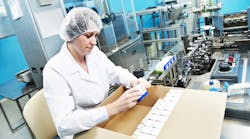For drug manufacturers, Industry 4.0 will look very much like Industry 3.0, just faster. The time saved in production will be a slow road ahead, and will mostly come at the very end of the transition when machine learning algorithms quickly make adjustments to the manufacturing line and production scheduling. The industry should be wary of over-fitting facilities with heavy machinery that may make them less agile and therefore less able to respond to changing markets. At this historic moment for the industry, companies should shift their focus to feature selection: the collection and curation of data. The variables selected today could be the game changers when AI models become industry standard.
FIFTY YEARS LATER, MORE OR LESS THE SAME
Although pharmaceutical firms have crossed galaxies discovering active pharmaceutical ingredients (APIs), the formulation of tablets hasn’t changed much in the last 50 years. “If we used a time machine to transport a pharmaceutical scientist from the 1960s into a current pharmaceutical production plant of today,” writes Lawrence Yu, FDA’s deputy director of the Office of Pharmaceutical Quality, Center for Drug Evaluation and Research, “it might be surprising to learn that they would already be very familiar with most of the processes and production techniques being used.”1
This is changing, however, and “what started with mortar and pestle has grown into more automated volume-controlled recipe processes that go through a quality check at each stage.”2 At first glance, the crux of the transition might appear to be the industry migrating from batch to continuous manufacturing. And indeed, several successful examples of this transition have made headlines in the last two years. Current rockstar Vertex was the first pharmaceutical company to use continuous manufacturing with its Orkambi drug, and in April of last year the FDA approved the first transition from batch to continuous manufacturing with Janssen’s HIV-1 treatment Prezista (darunavir).1 But, ultimately, the switch from batch to continuous is only a small part to the story. What is actually happening in the industry is more profound. Watching Industry 4.0 take over the horizon, many businesses are beginning to gut the processes incompatible with this new era of manufacturing.
Taking the right steps today can help prepare a pharmaceutical company for the great migration that will begin in tableting with the change from batch to continuous manufacturing, and ending with the implementation of machine learning.
HUMANS TEACHING ROBOTS TEACHING HUMANS
Humans are still preferred to robots in many facets of manufacturing because they can quickly transition to meet ever-changing production demands.3 “Agile means that the company is quick to adjust to changes in the market,” says Joe Berish, senior manager for Oliver Wyman’s Digital and Manufacturing Operations Practices. “In the sense of manufacturing, if you set up your system with all of these expensive robots that are very heavy, very hard to move and complicated to reprogram, then that’s not agile. People are flexible.”4
Over-outfitting, over-automation of a facility is an easy-to-make misstep for a company eager to meet the possibilities of Industry 4.0. Rather than buying-in, in regards to robots and automation, particularly in a manufacturing process as (arguably) rudimentary as tablet formulation, the first step a company should take is assessing and understanding the variables that will be fed into a machine learning model. “The biggest challenge companies will face in the implementation of machine learning to manufacturing is a lack of talent,” says Berish. “Humans are still the conduit for teaching machines what to learn, so it takes a special kind of “tweener” who understands the business and the algorithms. Even the latest trend of ‘machine learning for machine learning’ to help scale up quickly, still needs a starting point.”
FEATURE SELECTION
Many of the discussions about how to implement machine learning technologies to improve production — which at this stage should remain more on the philosophical end of the spectrum — too quickly devolve into the practical aspects of purchasing equipment, software packages, etc. Companies should understand that what might feel like a need to move from batch to continuous manufacturing, if done correctly, is actually a traditional business process reengineering (BPR), with a digital transformation of the company as the focal point. This is how tablet manufacturers will become part of a new industrial era. In the past, these BPRs took 10 to 15 years to rollout. However, becoming part of Industry 4.0 must be faster — much faster. By conservative estimates, it will take a quarter of this time. “If a company is ‘all-in,’” says Berish, “a digital transformation can put them at the forefront of the industry in as little as two or three years’ time.” He continues to explain that a true digital transformation would first include everything except manufacturing. “I don’t want someone to get the impression that if they do the manufacturing part, then they will be a leader.”
As we will be the conduits for these software suites, now is the time for the collection and organization of big data, or in the language of algorithmic modeling: feature selection. Instead of retrofitting a manufacturing line with the latest sensors and robotics, a business that takes the time and effort to find the best variables to feed into the model will dictate the speed at which machine learning algorithms can make adjustments that instill lasting changes to the manufacturing process.
TRANSLATING THE ART OF TABLETING
Drugmakers have been working with units of operation to mix, grind, test and mill in different batches since the 19th century.2 In this way, tablet formulation is akin to cooking and therefore must rely somewhat on the intuition of experts. But in Industry 4.0, the art of tablet formulation must be quantifiable. Furthermore, anecdotal and experiential knowledge must keep pace with technological advancements. For example, particle shapes and sizes of an API and its excipients, as known by formulation experts, might first have to be translated to new technological advancements in particle characterization before being considered valid variables for the model — this transition is the time to exchange antiqued variables for more accurate descriptors.
Eventually, as is the theory behind machine learning algorithms, these translational differences will cease to matter as the algorithm slithers its way between industries. Algorithms installed will be able to make adjustments in production based on upstream attributes of particle characterization at a partnering facility. The speed that they will be able to achieve this final goal depends on the time and effort put into the selection of variables today. Therefore, looking for talent for this transition might not mean finding the engineer with the best production experience, but rather the engineer with the best ability for language.
Although the machine learning algorithms will transform the tablet production, optimally implemented, “manufacturing should be the very last piece of the puzzle,” says Berish. “You can install all the sensors [on the manufacturing line] you want — and that’s okay — but at the end of the day, these sensors still need to know what to ‘sense.’” The abstraction here between sensors and what they sense is an important one. Recent attempts at drug formulation using machine learning algorithms implicate that it is not the number of variables added to the model, but which ones. Overfitting a model with many extraneous variables can lower the predictability of the model.5
THE PHILOSOPHICAL APPROACH: BLOCKCHAIN PRODUCTION
Respondents to the 2017 Nice Insight CRO Outsourcing Survey rated quality compliance, on-time delivery, and communication and transparency as three of the most important attributes that factor into post-CRO engagement.6 One of the least obvious ways that machine learning will have a positive impact on tablet manufacturing is production scheduling and quality compliance.
“Blockchain applications in the supply chain could enable instant reconciliation and adjustment of production schedules between suppliers and end manufacturers without any middlemen, thus lowering efficiency losses,” says Berish. Therefore, continuous drug manufacturing of the future will not only mean continuous manufacturing of one formulation using rapid feedback loops on the manufacturing line, but will extend the manufacturing line to encompass outsourcing partners across the globe. Much like how intercommunicating self-driving cars will be able to eradicate congestion in city centers, machine learning algorithms will decrease congestion and inactivity on tableting production lines by adjusting schedules based on the completion and quality of excipients at partnering facilities.
A total digital transformation of a company that requires similar compliance with its outsourcing partners will revolutionize the tablet manufacturing industry. In the near future, this will likely take the form of an industry standard, much like the ISO or cGMP certifications. “If you’re surprised when one day you’re being asked to comply to certain digital standards,” says Berish, “then you haven’t been paying close enough attention.”
Blockchaining of the industry will also aid in the selection of outsourcing partners based on machine learning algorithms. Imagine a “right-first-time” approach to formulation that has the potential to constantly improve as new excipients emerge.
INDUSTRY 4.0
As a rule-of-thumb, changes to more automation should be evolutionary, but lead to revolutionary results.7 Industry 4.0 in pharmaceuticals looks very much like a faster version of Industry 3.0. Machine learning algorithms will be able to quickly make adjustments to the manufacturing line and production scheduling, but these changes will mostly come at the very end of the transition. Now is the time for the businesses to collect and curate data, all while pondering the possibilities that Industry 4.0 could create for the future of the company.
REFERENCES
Yu, Lawrence. “Continuous Manufacturing Has a Strong Impact on Drug Quality” FDA Voice. Web. April 12, 2016.
Neil, Stephanie. “The New Pharma Factory.” Automation World. Web. February 11, 2016.
Harbour, Ron, and Steve Scemama. “Surprise: Robots Aren’t Replacing Humans In Key Areas Of Manufacturing.” Forbes. February 03, 2017.
Joe Berish, interviewed by David Torrone and Artrit Bytyci, March 28, 2017.
Akseli, Ilgaz, Jingjin Xie, Leon Schultz, Nadia Ladyzhynsky, Tommasina Bramante, et al. “A Practical Framework Toward Prediction of Breaking Force and Disintegration of Tablet Formulations Using Machine Learning Tools.” Journal of Pharmaceutical Sciences 106, no. 1 (January 2017).
The 2017 Nice Insight Preclinical and Clinical Contract Research Survey.
Columbus, Louis. “10 Ways Machine Learning Is Revolutionizing Manufacturing.” Forbes. June 26, 2016.





